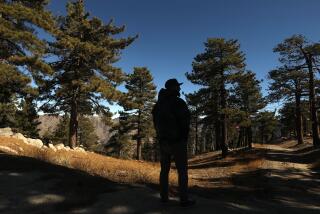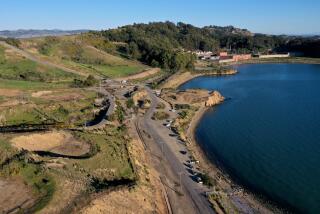Park Grows With Aid of Bond Issue
- Share via
Ascending the dramatic slopes of the Santa Clarita Woodlands on a sunstruck day, Rorie Skei can barely contain her affection for the place and what lives there.
“Aren’t you a pretty thing,” she murmurs to a rare Cooper’s hawk that has lighted in a barren tree alongside the old oil road toiling up the flanks of rugged Pico Canyon.
Near a stream that spills through Rice Canyon, a slender valley oak has strewn the footpath with acorns the size of a large man’s thumb. “The trees are so vigorous,” Skei says as she gathers a handful. “They’re so happy to be in parkland.”
The happiness quotient of trees is debatable, but no one can dispute that the trees--and the hawk and the stream and everything around them--are definitely in what is and will be parkland for many generations.
Whatever else it accomplished, November’s election guaranteed park status to the biologically unique Santa Clarita Woodlands, a high, wet and lushly forested oasis in a Los Angeles basin known primarily for dryness and scrub.
In passing the parks bond issue known as Proposition A, Los Angeles County voters handed a gift to woodlands preservationists like Skei, a division chief for the Santa Monica Mountains Conservancy. The gift was $2.45 million for the conservancy to finish buying 2,184 acres that form the trunk and vital organs of the proposed 7,000-acre Santa Clarita Woodlands park on the north slope of the Santa Susana Mountains.
The woodlands are a quilt work of vegetation uncommon to the Los Angeles area--forests so dense they form canopies overhead; rare stands of mixed conifers and hardwoods such as ash; entire forests of valley oaks, a species of tree that is the subject of intense preservation efforts elsewhere in California; chokecherry trees, which don’t grow in the Santa Monicas, the San Gabriels or even elsewhere in the Santa Susanas; California needle grass, the state’s most important native grass.
The conservancy agreed to buy the land from Chevron Corp. for $4.9 million--at about $2,000 an acre, a bargain--in April 1995. Chevron also donated 851 acres of Pico Canyon.
The conservancy came up with half of the $4.9 million as a down payment, and had five years to come up with the rest or perhaps lose the land. Thanks to the passage of Proposition A, a check for the second half is expected to be issued early this year by the Los Angeles Open Space District, which administers the $319 million generated by the bond issue.
The conservancy opened the bulk of the Chevron lands to the public in early 1996. Pico Canyon, which includes the 19th century ghost oil-town Mentryville, a prime candidate for development as a historical attraction, has been open on a limited basis since May.
The woodlands park runs along the west side of the Golden State Freeway, just north of the Antelope Valley Freeway interchange. Administered by an arm of the conservancy, it is composed of 4,000 acres of public open space, including 500 acres owned by Los Angeles County. At its southeastern edge it abuts Los Angeles’ O’Melveny Park.
For all its beauty and importance, the Chevron acreage is not the apex--scenically or geologically--of the expansive park that proponents envision. That distinction belongs to about 3,000 acres along the crest and upper north slope of the Santa Susanas, including 3,747-foot Oat Mountain, which remain in private hands.
“The park that we have now, most of it is pretty low,” said Don Mullally, a retired teacher and naturalist who was an early proponent of a woodlands park and who has written extensively on its natural characteristics. “It comes halfway up the mountain range. We’ve got the lower half, and now we need the upper half, and we don’t have any of it. That’s the part that bugs me the worst--the fact that we don’t own it, and that’s some of the nicest up there.”
The Santa Susanas separate the San Fernando and Santa Clarita valleys. Viewed from the floor of the San Fernando Valley, the pale, grassy south slopes of the mountains provide little hint of what lies on the other side.
But over the ridgeline, the north slope is so deeply green, it might be mistaken for a central or northern California woodland. “It’s the finest example in our zone of true forest wilderness,” Skei said.
On its upper reaches, stands of pointy, serrated big cone Douglas fir trees strain skyward. They, as well as abundant canyon live oak, are unusual at such elevations.
“To find the Douglas firs elsewhere, you’d have to go up to 10,000 feet in the Angeles National Forest,” Mullally said. “Here they come down to about 1,400 feet. Canyon live oak also comes down to its lowest elevation. We don’t know if it’s the environment or if it’s a special genetic type of the oak. Usually this type of tree is a high-mountain tree; it grows up in the mountains where it snows a lot.”
Mullally speculates that a number of natural forces converge to make the woodlands unique. Its relatively high elevation--which makes for some of the most stunning vistas in southern California--keeps it 10 to 15 degrees cooler than the valley floors. Light snow is common above 2,500 feet, and average rainfall is about twice that of the land below. Numerous waterfalls and year-round streams traverse the park’s canyons, which fold in complicatedly on one another.
The lands of the proposed park, Skei said, are vital to the conservancy’s plans to establish a long-term wildlife habitat linking the various mountain ranges in the region.
“The linkage now runs from the Los Padres National Forest over to the San Gabriels and the Angeles National Forest,” Skei said. “As long as we keep the habitat flowing south--the Simi Hills, the Santa Susanas and the Santa Monicas--we guarantee the survivability of large mammal wildlife. Otherwise the various populations become isolated and inbred. You can have lots of pretty, open area and still have a desert, biologically speaking.”
The conservancy’s strategy in creating the park has been to buy parcels of land that block access to scenic acreage that otherwise might tempt developers.
In 1989, it acquired for $500,000 145 acres in Towsley Canyon--an area now known as Ed Davis Park--and effectively stymied the possibility that the Los Angeles County Sanitation Districts would open a garbage dump in the canyon.
A year later, the conservancy bought 22 acres at the entrance of East Canyon for almost $5 million. The purchase, though costly, blocked commercial access to the scenic canyon, which was owned by Chevron, and decreased access to the rest of the Chevron property.
The purchase of the Chevron land in 1995 in turn tightened the access noose around the 3,000 acres of privately owned high ground the conservancy covets for the park. Its purchases effectively have blocked access from the north side of the mountains. The Southern California Gas Co. storage fields at the end of Tampa Avenue in the San Fernando Valley block access from the steeply pitched southern side.
Skei is optimistic about the conservancy’s prospects for acquiring the remaining lands.
“I think we’re in a good position. I don’t think it’s going to be expensive. There are a number of very willing sellers who have been knocking on our doors for years, but they may have a value in mind that may not be supported by appraisal. It’s more a matter of matching willing sellers to available funding.”
(BEGIN TEXT OF INFOBOX / INFOGRAPHIC)
About Santa Clarita Woodlands Park The main entrance to the Santa Clarita Woodlands park is at 24255 the Old Road, Newhall, a quarter-mile west of the Calgrove Boulevard exit off the Golden State Freeway. The entrance is marked by a sign reading Towsley Canyon Park.
Information about trails leading to various canyons in the park is available at a visitors center inside the main entrance.
The park is open from sunrise to sunset daily. The park’s Pico Canyon, which includes the ghost town of Mentryville, is open only the first and third Sundays of the month, from noon until 4 p.m.






